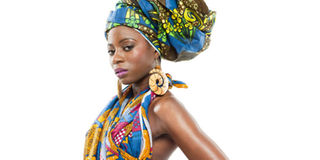No longer that African

Walking into one of the shops selling African fabric downtown, I am amazed at how much people are ‘swallowing up’ these fabrics; the buzz is undeniable. With various names being coined by the buyers, the amazement continues, “how do they get these names? And how is it that the sellers seem to know what each buyer is saying?”
Kitenge, African fabric, African print, chitenge, sarong, zambia, capulana, nguvu, vemba, kanga, wax, telel; the names are quite many, and so are their variations. They have got palettes so bright and clashing, they threaten to sear the eye, and patterns are so loud, they make Hawaiian prints look demure.
Kitenge flourishes in East Africa and parts of Southern Africa. They are often worn by women and wrapped around the chest or waist, over the head as a headscarf, or as a baby sling. Other African print materials include Shweshwe; a printed dyed cotton fabric used for traditional clothing in South Africa, Ankara commonly known as Dutch print found in Nigeria, Aso one; a hand-loomed cloth, woven by the Yoruba in Nigeria mainly for special occasions, Adire; an indigo dyed cloth also from the Yoruba but only made by Nigerian women, Baoule; a woven fabric with wide strips found in Cote d’Ivore, Kente; a brightly coloured inked material with different patterns and designs found in Ghana, Bogolan or bogolanfini; known as the mud cloth as it is traditionally dyed with fermented mud and is from Mali, Duda; a raffia cloth by the Duda people in Ivory Coast, and Kaaba; fabric for wooden blankets from the Fulani people in Mali.
While it may seem that the Kitenge is deeply ingrained in the African culture, according to Grace Kyomukama of Ug Bridals, the term African print is indeed misleading because the fabrics are neither made in Africa nor designed by Africans. They are made from countries outside Africa but certain African countries have embraced them and made them their own.”
Yinka Shonibare, a renown British-Nigerian artist says, “The fabrics are not authentically African the way people think. They prove to have a crossbred culture background quiet of their own.” In another post, Shonibare says, “The origin of what we call African fabric is Indonesia.”
Wondering why designers such as Vilsco produce what we call African print with such great African presence, Roger Gerard’s, Vilsco’s creative director says, “Historically, a lot of our designs were created at the request of certain African traders.”
Angela Birungi of Birungi Designs goes further into how this fabric made its way to Africa saying, “Kitenge was first made for Europeans but with Africa between Asia and Europe, we benefitted from the trade as the ships docked here before sailing off to their final destination.”
Assumpta Namirembe of Assumpta Mutunzi Fashion Store says, “I mainly use Nigerian and Congo Wax for my work as it is purely cotton. However these African print fabrics or Kitenge as it is commonly called mainly originate from China.” Asked why this is so, she explains, “In making these materials, plant dyes are used. However, it gets costly to do this with mass production.
So the Chinese only look at re-producing the final print on the material without using the original dyes. In addition to that, the cost of cotton is low in China.”
She also adds that other African fabrics are made in Holland.
Wacy Zacharias a Mozambican entrepreneur says, “It’s like a borrowed culture; it is no longer ours. Unlike the woven material that was seen among our forefathers, the textiles today have nothing really about African heritage in them. It’s just someone or some company in China or a Europe dictating what is African now.”




